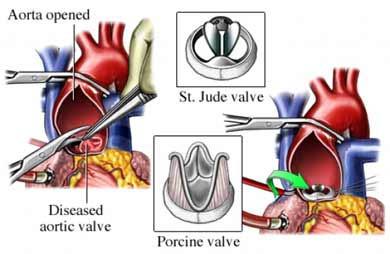Aortic Valve Repair / Replacement (AVR)
Aortic Valve Repair / Replacement (AVR)
Aortic Valve Repair (AVR)
Aortic valve repair and aortic valve replacement are procedures that treat diseases affecting the aortic valve, one of four valves that control blood flow through the heart.
The aortic valve helps keep blood flowing in the correct direction through the heart. It separates the heart's main pumping chamber (left ventricle) and the main artery that supplies oxygen-rich blood to your body (aorta).
With each contraction of the ventricle, the aortic valve opens and allows blood to flow from the left ventricle into the aorta. When the ventricle relaxes, the aortic valve closes to prevent blood from flowing backward into the ventricle.
When the aortic valve isn't working properly, it can interfere with blood flow and force the heart to work harder to send blood to the rest of your body. Aortic valve repair or aortic valve replacement can treat aortic valve disease and help restore normal blood flow, reduce symptoms, prolong life and help preserve the function of your heart muscle.
Aortic Valve Replacement (AVR)
In this procedure, your doctor removes the aortic valve and replaces it with a mechanical valve or a valve made from cow, pig or human heart tissue (valve). Another type of biological tissue valve replacement that uses your own pulmonary valve is sometimes possible.
Often, biological tissue valves eventually need to be replaced because they degenerate over time. If you have a mechanical valve, you'll need to take blood-thinning medications for the rest of your life to prevent blood clots. Doctors will discuss with you the risks and benefits of each type of valve and discuss which valve may be appropriate for you.
During Procedure
Aortic valve repair is usually performed through traditional open-heart surgery and opening of the chest bone (sternotomy). Doctors wire the bone back together after the procedure to prevent movement and aid in healing.
Types
1. Annuloplasty
An annuloplasty is a procedure to tighten or reinforce the ring (annulus) around a valve in the heart. It may be done during other procedures to repair a heart valve.
2. Valvuloplasty
A valvuloplasty, also known as balloon valvuloplasty or balloon valvotomy, is a procedure to repair a heart valve that has a narrowed opening.
In a narrowed heart valve, the valve flaps (leaflets) may become thick or stiff and fuse together (stenosis). This reduces blood flow through the valve.
Symptoms:
Your doctor may recommend valvuloplasty if:
You have severe valve narrowing and are having symptoms
You have narrowing of the mitral valve (mitral valve stenosis), even if you don't have symptoms
You have a narrowed tricuspid or pulmonary valve
You or your child has a narrowed aortic valve (aortic valve stenosis)
Diagnosis
• Echocardiogram
• ECG
• Chest X-ray
• TEE Test
• Blood tests
A valvuloplasty may improve blood flow through the heart valve and improve your symptoms.
Complications after Procedure
• Infection
• Blood Clots- This is more likely if you have mechanical valve replacement
• Stroke or Transient Ischaemic Attack
• Irregular Heartbeat (arrhythmia)
Duration: 4-5 Hours
Success Rate: 95- 98% may vary according to patient's condition.
Stay in Hospital: 8 days
Stay in India: 20-25 days

